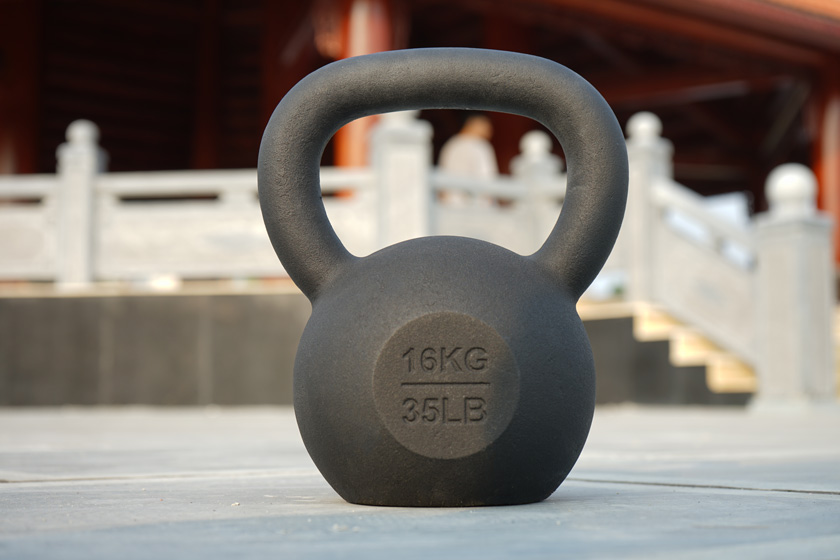If you can only get one piece of gym equipment in your space, a well-chosen kettlebell with a good handle on top should be at the top of your list. One fundamental element that leads to a great handle, among others, is its smoothness. So, for those who are asking, “What will be the kettlebell ideal handle smoothness?” here are some pointers.
Despite several claims of “not being effective enough,” “completely useless,” and so on, kettlebells have recently regained their reputation, substantiated by a slew of credit from both professionals and regular fitness trainers.
Indeed, who would have guessed that a single basic shape could offer such an array of applications in the fitness world? So what makes it so noteworthy? Partly due to the smoothness of a high-quality handle.
Overwhelmed by a multitude of kettlebell handle choices but can’t decide what to choose or don’t know where to start?
Scroll through to see what a perfect smoothness of a handle should be like.
How critical is a smooth handle?

People still say things like, “to get a better workout, experience the highest degree of comfort, and avoid injuries, strive for the premium handle smoothness.”
So why is it so important?
Regarding the performance of ballistic movement exercises in the kettlebell category, the handle will do most of the job in swinging or snatching, which is unlikely to happen with the other free-weight relatives such as dumbells or barbells.
What exactly is a ballistic movement, you might ask?
Basically, ballistic movement is described as muscle contractions with maximum velocities and accelerations in a concise amount of time. They provide high firing speeds, high force production, and short contraction periods.
To boost explosive power, ballistic training, also known as strength training, involves throwing weights and jumping with weights. This aims to optimize an object’s acceleration process while minimizing its deceleration phase.
During these movements, the handle of the kettlebell will rotate within the grip, generating friction.
As a result, kettlebells come in with rough edges left on the handles from the casting process or insufficient coating can cause discomfort and cuts during high-repetition workouts.
If in proper form, you may not experience any struggle or pain at a few first regular sets of 10 to 20 reps.
However, when progressing to higher repetition sets or more strenuous workouts, a smooth handle is required to eliminate awkward grip, palm injury and support the entire training process.

Some might try to continue lifting while in suffering, motivated by the slogan “no pain, no gain,” but soon, the wounds or even bleeding from these nicks will injure your hands badly, and of course, the training will not be benefited.
What’s more, the friction can cause you to deviate or even ruin the form due to inadequate concentration. Instead of devoting full attention to train a specific muscle group, you would have to dedicate more than half of your time and effort to endure the pain.
In fact, we believe that you might have misunderstood the word “pain” described in the slogan; it was not intended to refer to an accident or injury, but rather to the sore in your muscles when you’ve successfully triggered them.
What if the kettlebell handle is Too smooth?

Remember that whatever goes with the word “too” is not always a positive thing; in this case, it would be the “too smooth” options.
In the sports market, kettlebells are sold in a variety of styles and coating surfaces, including powder coating, conventional paint, e-coating, urethane covering, or even unadorned ones with no coating at all.
With the exception of the first one, the rest tend to have excessively smooth surfaces, owing to the feature of the coating itself. Advertised as a durable addition to your weights with multiple colors to choose from, it really does strike buyers’ sentiment as someone seeks to fill their weigh-rack with stylish, durable kettlebells without worrying about chipping.
However, the major point is whether or not these coatings have any impact on your training experience?
The answer to that is yes.
To use kettlebells with such slick handles, you must be extra cautious or if you are fine with applying chalk to improve grip in the hand when perspiring.
Otherwise, the handles of the kettlebells mentioned above would be considered as “too smooth,” creating a lot of annoyance and potentially distracting you from the main objective of the workout.
So how to know if a handle is “too smooth” or not?

Try the 2-Hand Kettlebell Swing workout (with modest weight).
If you find yourself focusing too much on gripping the handle firmly to prevent it from sliding out of your grasp, this handle might be too slippery for you. However, this is when you choose to boost your overall strength and conditioning.
On the other hand, if you have vast expertise in fitness training and want to push yourself to strengthen your grip ability, you can look into kettlebells with slick handles.
One of the most challenging exercises to improve grip strength is to put soap on your hands and do 100 reps of the same exercise, the 2-Hand Kettlebell Swing. Soap on a smooth kettlebell handle, similar to having extremely wet palms, can force you to squeeze the handle harder than ever.
Check out the stainless steel competition kettlebells with no handle coating to clarify why the “too smooth”handle could be designed for a reason. As the name suggests, these kinds of dumbbells are built for another level – a higher degree of use and high rep sets. As a result, to be qualified, trainers must overcome exceptional lifting challenges, which is not present in classic kettlebell training. The kettlebell used must also be adaptable for many competitors, so the “raw” surface is needed to provide the desired flexibility.
What about the kettlebell handle that is Too gritty?

For those who think a kettlebell is merely a piece of metal that is machined into a strange shape and doesn’t deserve a decent investment, considering this.
Poor construction with no rust or chip-resistant surface (or cheap-quality one) will not only mess up the diameter and the dimension from the handle to the bell, but it will also make the handle gritty.
Using this kettlebell, you’re putting your hands at risk.
They will undoubtedly torment and tear up your palms in no time, despite all of your attempts to maintain proper form, limit reps, and the intensity of each exercise.
When you buy cheap kettlebells, and they arrived looking bumpy, or when you notice nicks or lines under the kettlebell handle, you know was your purchase worthwhile or not.
Read more: Is it worthy buying cheap kettlebell?
What makes a kettlebell handle Just right?

A moderate handle must converge several elements.
In addition to the standard-followed diameter and distance to the bell, the ideal smoothness is not to be missed.
So what is the kettlebell ideal smoothness?
As previously stated, a kettlebell handle that is too smooth can be hard to control because it requires tons of grip strength. To perform exercises with this kettlebell handle, you have no choice but to lower the weight or adding lots of chalk, which can be quite a nuisance. On the other hand, the one that is too gritty can severely damage the hands.
To deal with this, some individuals might be thinking that they can use fitness gloves when exercising with kettlebells so that they don’t have to worry about the handle is “good enough” or not.
However, you may rarely see anyone who got a toned body and amazing muscle wearing one at the gym. Even fitness professionals and athletes do not recommend using them.
Not to mention that there will be times when they are not by your side.
So for the most efficient and consistent training experience, go for a kettlebell that is not only durable, but the handle has to be “just right.”
The desired smoothness for most kettlebell handles should be based on a combination of smoothness and grittiness for the best performance.
To keep it simple, imagine the surface of the sandpaper – a “just right” handle for standard practice should be a completely smooth handle that is lightly sprinkled with sand.

This surface texture will be smooth enough to not irritate your hands while remaining rough enough for you to master the bell during any exercises.
The powder coating technique is a classic example of this surface coating; its sandpaper-like texture allows trainers to do multiple ballistic lifts without the strain of gripping too tightly while protecting the skin on your palms.
Read more: Why powder coated kettlebells are the most prefered?
In terms of professional usage for more intense and high-rep works, tired of the cloud of chalk getting in the way? Try to add a light coat on the powder-coated handle, and you’re good to go.
In a nutshell
Kettlebells are not like any typical pair of dumbbells.
They are the most versatile and interesting pieces of exercise equipment available in the fitness market and worth a lifetime investment. It means that before you invest in one or an entire set, consider various factors, including the smoothness of the handle.
Don’t hesitate to do some research, and feel free to experiment with different types to find out what works best for you.
Wish you make it a great buy!
Read more
Single cast kettlebell Vs Cement Filled Kettlebell: How to tell the difference?
How high quality kettlebells are ensure to deliver to clients?


